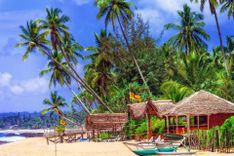Where to stay in Sri Lanka: From budget to luxury
You don’t need deep pockets to find a great place to sleep in Sri Lanka – especially when you’re hopping between hill towns, surf beaches, and national parks. Budget stays are easy to come by, particularly in spots like Ella, Mirissa, and Anuradhapura. Dorm beds or basic rooms can go for as little as $10 a night – think mosquito nets, fan-cooled rooms, and a soundtrack of frogs, dogs, and the odd passing tuk-tuk.
Spend $30-70 a night and you’ll get a serious upgrade. Mid-range accommodations in Sri Lanka often come with private balconies, hot showers, good Wi-Fi, and home-cooked breakfasts. Boutique guesthouses in places like Galle or Nuwara Eliya bring extra flair – old colonial bungalows, garden courtyards, and hosts who’ll help plan your next move.
Want to splurge? High-end stays in Sri Lanka start around $100 a night and stretch well into the hundreds. We're talking tea estate villas in the hills, private beach cabanas in Tangalle, and safari lodges on the edge of Yala – plunge pools, Ayurvedic spas, and zero effort required.
Best accommodation types in Sri Lanka
Sri Lanka’s accommodation scene is just as varied as its landscapes. From tea-plantation stays to beachside cabanas, you’ll find something for every budget – and every kind of trip. Here’s what to expect from Sri Lanka accommodations, whether you’re chasing waves, wildlife, or pure downtime.
Homestays and guesthouses
From $10 per night
Widespread across the island – especially in places like Ella, Polonnaruwa, and Jaffna – homestays are the soul of accommodations in Sri Lanka. Expect simple rooms, mosquito nets, and unbeatable hospitality. Home-cooked rice and curry are usually included (or easily arranged), and you’ll often be treated more like family than a guest.
Tea estate bungalows
From $30 per night
In the hill country – Nuwara Eliya, Haputale, and Hatton – you’ll find colonial-era bungalows with sweeping views of tea fields. Some are part of working estates; others have been turned into boutique stays. It’s all about veranda views, hot tea, log fires, and misty morning walks through the plantations.
Beach cabanas and surf lodges
From $15 per night
Head to Arugam Bay, Hiriketiya, or Midigama and you’ll find rustic beach stays just meters from the surf. Bamboo walls, ceiling fans, and cold showers are the norm, but the vibe is unbeatable. Many places double as cafés or surf schools, with hammocks out front and reggae on loop.












